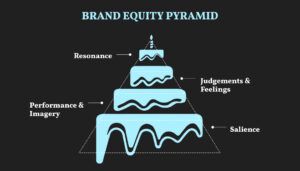As you read this, you might be thinking, “of course my brand is more than my logo.” Or maybe you’re thinking about the way consumers view you through Keller’s brand equity pyramid.
But in true Rebel fashion, I’m going to break it down differently. In fact, your brand is like a cake. And we’re hungry.
The Brand Kitchen
Let’s set the scene. You’ve decided to launch a business, are rebranding your current business, or are experiencing another of the milestones in the lifecycle of a business in which a brand needs to be ~ baked ~. You need to gather the correct tools and ingredients to create a one-of-a-kind brand experience.
It’s important when building a brand that you think ahead. How will your brand be perceived? How do you create a seamless experience for your customers? How will you talk about your brand when rolling it out? This is what I would refer to as reading the entire recipe before you begin (for any chefs reading out there, there is nothing more frustrating than getting 5 steps through a recipe only to find out that you actually have to refrigerate the ganache for 4 hours before you can get to step 6). When beginning to bake your brand it’s crucial to let things set properly before moving on! A rushed brand can result in a broken ganache or, in marketing terms, a failed brand.
The Basic Recipe
Before I get too deep into this “your brand is a cake” analogy, let’s get to know the ingredients.
First, the cake itself. This is going to be where most of your brand is established. It’s the very essence of your brand and needs to be fully baked (developed) before you build your layers or put on any frosting or decorations. It’s where all the raw ingredients come together — like your brand strategy and personas — to become a fully baked brand cake. (Is anyone else craving cake now?)
Following is a list of your core brand cake ingredients.
Audience Personas
Your personas — typically, you’ll create more than one — represent your potential customers; who you’re speaking to and why. A good audience persona should speak to:
- Demographics — Age, location, job title, gender.
- Psychographics — Personality, attitudes, lifestyle, pain points, interests.
- Behaviors — What social media channels do they engage with? Who do they follow? What kind of content are they most interested in?
This will help craft a comprehensive perspective regarding your target audience, one that will help shape your messaging and sales strategies.
Brand Persona
Your brand persona is the literal personification of your brand; someone with a heart and soul. Like a person, your brand persona expresses your characteristics, values, voice, and goals. It communicates what you do and what you stand for, creating an emotional association. You may choose to also lean into a Brand Archetype, aligning your brand persona with a personality based on psychological characteristics and behavior, which can often help in structuring your persona as something larger than yourself.
In short, your brand is your “who,” and that who is someone you want consumers to spend time with.
Mission & Vision
This is your “why,” the flavor of your cake.
Your mission statement should speak to your business objectives — why you do what you do — and how it will reach those goals. Your vision statement will detail (you guessed it) your vision, and your ultimate aspirations for the business.
The goal is to get your customer to believe in your mission and vision; to become your brand evangelists and advocate for your brand at every birthday party, first date, happy hour, and definitely during the first two minutes of any Zoom call while you wait for the rest of attendees to join.
Differentiator
In a landscape where almost everyone is exploring the beauty of entrepreneurship in a post-COVID world, it’s more important than ever to differentiate your brand from your competitors. That doesn’t need to cost a lot of money. Some of the most successful differentiation strategies have been built on copy alone.
Dollar Shave Club (DSC) subscription-based razor program is a great example. Early on, their differentiation strategy (“For a dollar a month, we send high-quality razors right to your door”) took almost 20%1 of the market share from titan Gillette. DSC got there by looking at the gaps in their competitors’ offerings and audience personas. They found that customers were looking for a shaving product that was high-quality, fit their needs, and offered an easy path-to-purchase. With this simple — and frankly brilliant — brand differentiation, they cleared a path for themselves that put Gillette on the defense.
Tagline
Not all taglines are effective and some brands don’t even use them, but they can be a great tool for succinctly explaining your differentiators. A good tagline is short and memorable — and a great partner in crime for your logo. Nike’s “Just Do It” likely comes to mind, but any business, small or large, can create a tagline that perfectly compliments their brand messaging.
Core Messaging (and Tone)
Core messaging goes beyond how you plan to talk about your brand, or even the tone in which you talk about it. It’s all about how your audience will get to know your brand persona. This is your elevator pitch, but with a lot more time to sell it. When crafting core messaging, it’s important to think about amplifying the key components of your brand. Is it that you’re chocolate cake with a raspberry ganache? Or maybe it’s that you can make your cake in any size or shape they require. Or it could be that your cake isn’t a regular cake, it’s actually 13 cupcakes stacked together. Whatever your differentiator and persona may be, it should be crystal clear in your tone and thus your core messaging strategy.
Brand Identity
Most people’s favorite part of a cake is the sweet, but not too sweet, frosting and decorations. That frosting is your brand identity. It’s your logo, font choices, brand colors- and all the outward-facing elements that your audience will come to associate with your brand. This is where you can make design magic happen — just make sure your brand identity is aligned with your brand strategy.
Logo
Your logo is often synonymous with your brand. (If you don’t believe me, take this quiz). And while that can be a good thing, it can sometimes be a barrier to evolving your brand. Take Twitter, or X, for example. The evolution of the Twitter logo is one of the most popular examples of a logo replacing a brand name, but that conflation is likely one of the reasons the X rebrand was such a shock to consumers. A well-known logo was suddenly replaced with the unknown. While you can’t predict the future of your brand’s logo, you can control the messaging around that evolution. Have your logo fit your brand persona and do consumer testing if possible.
Brand Colors
When looking at your brand colors, consider color psychology, the way certain colors make the consumer feel. This can help support your brand messaging by subtly suggesting a feeling associated with your product or service. Take, for instance, Tiffany Blue®.- Its turquoise blue color is so linked to Tiffany that they were able to trademark the color as an extension of their brand. The color was supposedly originally chosen due to its association with the elegance of Victorian brides. Tiffany Blue is more than a [brand] color. It’s an international icon, epitomizing sophistication wherever it appears.2
Fonts
Similar to your brand colors, there is a whole theory behind choosing the right font for your brand. A good font will convey a message, create visual hierarchy, and connect with your audience. It should also evoke emotion. Think about how you feel reading this word versus this word. The first one is much more elegant and soft, whereas the second one is comic sans (need I say more?).
The Bakery
So, we’ve built a delicious brand cake. It’s definitely more than just your logo, right? Now what?
In your upfront brand building and competitor mapping, you likely identified platforms and purchase points for your potential customers (i.e., where you’re selling and where they’re buying). Odds are that these two answers will be the same. If your audience shops at Walmart bakery on a $25 cake budget, they probably aren’t frequenting their local bakery to purchase a two-tiered, $200 custom chiffon lemon cake. Matching your brand strategy and identity with your platforms and messaging is the key to success.
Your brand, and your audience, will likely change over time, so it’s crucial to remain tuned in on what your customer is asking for both from you and from competitors in order to grow your brand in the long term. I like to call this vowel reporting: A(analyze), E (evolve), I(invest), O(optimize), and U (USP, or unique selling point). Taken together, your USP, sales and customer data analysis, brand equity, and other factors compose the data that, when used properly, can help you optimize the investment you make in your brand, evolving it for the long haul in concert with shifts in your industry, the market, and your audience. It may sound a little crazy, but trust me, it’s not.
Are you looking to elevate your brand? Rebel can help you bake that cake.
Sources:

